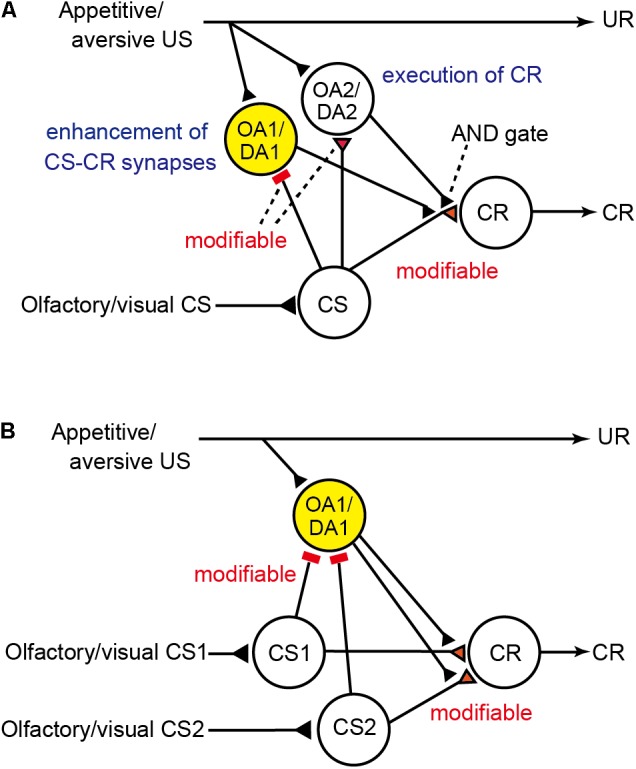FIGURE 1.

Neural models of Pavlovian conditioning in crickets proposed by Terao et al. (2015) and Terao and Mizunami (2017). (A) Description of the model that has been revised from the model by Mizunami et al. (2009) to match the prediction error theory. The model assumes two classes of OA and DA neurons. One is “OA1/DA1” neurons (colored in yellow) that govern enhancement of “CS-CR” synapses (but not execution of a CR). The other is “OA2/DA2” neurons that govern execution of a CR or memory retrieval (but not enhancement of “CS-CR” synapses). The model also assumes that (1) “CS” neurons [which may represent intrinsic neurons (Kenyon cells) of the mushroom body] that convey signals for CS make silent or weak synaptic connections with dendrites of “CR” neurons [which may represent efferent (output) neurons of the lobes (output regions) of the mushroom body], activation of which leads to a CR, but these synaptic connections are silent or very weak before conditioning, (2) “OA1/DA1” neurons receive excitatory synapses that represent appetitive/aversive US signals and silent or very weak inhibitory synapses from “CS” neurons before training, which are strengthened by CS-US pairing, (3) during training, “OA1/DA1” neurons receive excitatory synaptic input that represents actual US and inhibitory input from “CS” neurons that represents US prediction by CS, and thus their activities represent US prediction error signals, (4) “OA2/DA2” neurons receive excitatory synapses that represent US signals and silent or very weak excitatory synapses from “CS” neurons before training, which are strengthened by CS-US pairing, and (5) “OA2/DA2” neurons make synaptic connections with axon terminals of “CS” neurons, and coincident activation of “CS” neurons and “OA2/DA2” neurons is needed for activation of “CR” neurons (AND gate) and for production of a conditioned response. Presentation of a CS after CS-US pairing activates “CS” neurons and then “OA2/DA2” neurons and thus activates “CR” neurons to lead to a CR. Synapses for which the efficacy can be changed by conditioning are colored in red and marked as “modifiable.” Excitatory synapses are marked as triangles, and inhibitory synapses are marked as bars. UR: unconditioned response. (B) Accounts for blocking by the model. “OA2/DA2” neurons in the model in (A) are not shown in (B) for simplicity. The models are modified from Terao et al. (2015) and Terao and Mizunami (2017) with permission.
